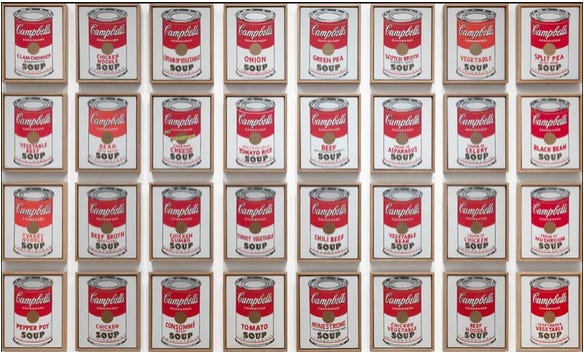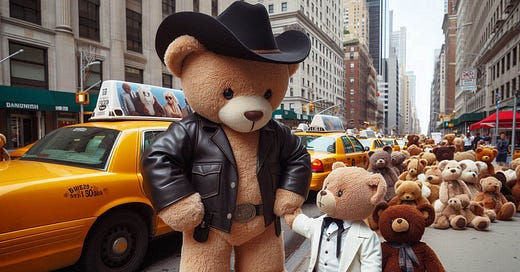“How could these rebellious, outrageous X-rated1 films about these lowlifes make all that money?” That was the question on the studio heads’ minds as they considered two 1969 films: Easy Rider and Midnight Cowboy.2
Midnight Cowboy isn’t much of a “plot” movie. Instead, you need to know the characters:
Rico Rizzo (Dustin Hoffman), derisively called “Ratso,” a con artist with a bum leg and a tubercular cough.
Joe Buck (Jon Voight), the handsome but naïve Texas dishwasher who quits his job and moves to New York to become a prostitute.
Joe finds there’s no market for what he’s selling and runs out of money. Ratso scammed Joe out of $20 when they first met, but now he offers to let Joe room with him in a condemned building. Their platonic relationship is the key to the film: Ratso finds someone who loves and cares for him and Joe finds that he can love and care—that relationships don’t have to be purely transactional.
When Ratso’s health deteriorates, he asks Joe to take him to Florida. Joe steals money for the trip from one of his johns and the two hop on a Greyhound. In Florida, Joe discards his cowboy getup and tells Ratso:
When we get to Miami, what I’m gonna do is get some sorta job. I gotta do that, ‘cause see, I ain’t no kind of a hustler. I ain’t even any goddamn good as a bum. I’m a nothing, that’s what I am. So reckon I’d better go to work and get me a goddamn job.3
Then he looks over and notices that Ratso has died and the movie ends.
But what’s the one thing people remember from this film? When Ratso yells “I’M WALKIN’ HERE” at a yellow cab.
Rating: 7/10, up yours you son of a bitch, you don’t talk to me that way.
Cast and Crew
We last saw Dustin Hoffman in The Graduate, the film that catapulted him from no-name to A-lister. But an accusation dogged him: was he really acting in The Graduate? Or was he just, like, a dude who was pretty similar to Benjamin Braddock?
After The Graduate, Hoffman went back to Broadway and waited for a film role that’d show that he could act. He found it in Ratso, the anti-Benjamin Braddock: urbane, weaselly, sickly, dirty. Mike Nichols, director of The Graduate, said playing Ratso would ruin Hoffman’s career. Evidently, that was not the case—we’ll see Hoffman many more times in this column.
This film is the breakout for Jon Voight, and his lunk of a hustler is great. How about this: today we’ll tell you the absolute must-know stuff, then dig into some deeper cuts the next few times we see him.
He was nominated for three Best Actor Oscars: Midnight Cowboy, Coming Home (1978), and Runaway Train (1985).
He’s well-known for his roles in Deliverance (1972), Conrack (1974), and Mission: Impossible (1996).4
He played Liev Schreiber’s dad on the Showtime series “Ray Donovan” (2013–2020) and is Angelina Jolie’s real-life dad (she was born Angelina Jolie Voight).
Harry Nilsson’s cover of “Everybody’s Talkin’” refrains through all of Midnight Cowboy. The song is one of the things you’re expected to know about this film.
Nilsson was known as one of the premiere songwriters of the ‘60s and ‘70s, but his most-recognizable song is probably the novelty “Coconut” (that’s the one about putting the lime in the coconut and drinking it all up). He did get one track to #1: “Without You,” which you can read about here.
One wild non-musical fact about Nilsson: both Keith Moon (the drummer for The Who) and Mama Cass Elliott (from the Mamas and the Papas) died in his apartment.
The Trivia
Ratso and Joe go to a function that’s basically an Andy Warhol Factory party,5 so today we’re talking about the 20th century’s premiere pop artist. What’s, like, the first thing you’ve gotta know about Warhol? This.

Ah, okay, he’s the soup can guy. The cans and many of Warhol’s other famous pieces were made using silkscreens, which push ink through a mesh and use a stencil to control the image. There’s not much in the way of technique to the production of these prints, and as such the “Factory” associated with Warhol was named for the mass-production techniques he employed. That means your mileage may vary with whether or not you even consider this “art” at all.6
Besides cans, Warhol is known for his silkscreens of Coke bottles and electric chairs, along with those of famous people like Marilyn Monroe, Elizabeth Taylor, Elvis, Jackie Kennedy, and Mao. He also did reproductions of mundane commercial artifacts like Brillo soap pads, Mott’s juice boxes, Del Monte peaches, and Kellogg’s cereal.
That’s Warhol as a visual artist, but he was also a filmmaker. His early films sound unwatchable: one was just five hours of a dude sleeping, another was eight hours of the Empire State Building. Warhol commented that these films weren’t meant to be watched, but instead were designed to be sporadically engaged with. I guess he was ahead of his time, since this is also Netflix’s approach to content. If you dare, we’ve highlighted some more of his films in the following footnote.7
But perhaps more important than knowing the art is knowing about Warhol’s impact on the culture.
He said the line “in the future everyone will be world-famous for 15 minutes.” We live in that future now and it is terrible (though you get the feeling Warhol woulda loved NFTs and Hawk Tuah).
He was shot in 1968 by Valerie Solanas, a former Factory member. This was dramatized in the 1996 film I Shot Andy Warhol.
He’s strongly associated with Pittsburgh8, and that’s where the Andy Warhol museum is today. His real last name was “Warhola.”
He founded “Interview” magazine.
He’s been played on film by David Bowie, Crispin Glover, Guy Pearce, Jared Harris, and, uh, Bill Hader.

He produced the first album by the Velvet Underground (led by Lou Reed and John Cale). He also designed album covers, including the Velvet Underground’s self-titled and the Rolling Stones’ “Sticky Fingers.”

WARNING: don’t mix Warhol up with Roy Lichtenstein, another pop artist.
Odds and Ends
John Schlesinger directed; his biggest film is this one, but we’ll see his work again…Midnight Cowboy was based on a novel by James Leo Herlihy, who also wrote “All Fall Down”…Ratso asks for a sawbuck from Joe; “sawbuck” is just slang for a ten-dollar bill…Joe Buck is also the name of a football and baseball announcer that we used to goof on but that we don’t goof on as much any more…the most famous of Warhol’s superstars was probably Edie Sedgwick, but you should know Nico as well…
Last thing: John Wayne connects to this movie in three specific ways:
He’s specifically mentioned in the movie. Ratso, referring to Joe’s clothes, says “that great big dumb cowboy crap don’t appeal to nobody […] that’s [f-slur] stuff.” Joe, surprised, replies, “John Wayne—you gonna tell me he’s a [f-slur]?”
John Wayne himself called Midnight Cowboy “a story about two [f-slurs],” which is not really the right reading of the film.
John Wayne beat out both Hoffman and Voight for the Best Actor Oscar. We’ll watch the movie he won for next week.
Midnight Cowboy is the only X-rated feature to win Best Picture at the Academy Awards, though it has since been re-rated as R. Note that the M.P.A.A. initially assigned the film an R but the head of United Artists had it changed to an X, since he worried the film would give young moviegoers the wrong idea about sex.
Yeah, we’ve described The Graduate and Bonnie and Clyde as proto-New Hollywood, but Midnight Cowboy makes those movies look like Gone with the Wind.
That’s actually the line from the shooting script, which I think is a bit more evocative of what Joe’s thinking. In the film, it’s a bit different.
Those three movies, each in two words: canoe ordeal; white savior; impossible mission.
And, in fact, two of the actresses in the film—Sylvia Miles, who scored a Best Supporting Actress nomination, and Viva—were both associated with Warhol and the Factory. Also, watching parties where people do drugs can be lame, like in Charly, but this one’s not that lame.
Pop art was an art movement that blended high art with mainstream imagery. From what I remember from Tom Wolfe’s “The Painted Word,” art in the middle of the 20th century had become less about aesthetics and more about a physical representation of theory (see abstract expressionism, minimalism, conceptual art). Pop art maintains the theory piece—the purity of formal elements, repetition, flatness, rejection of emotion—but repackages it with images of stuff people actually like.
Note Chelsea Girls (1966, which featured the women Warhol called his “superstars” at the Chelsea Hotel), Lonesome Cowboys (1968, a homoerotic Western parody), and Trash (1970, name is probably accurate). These three films were directed or co-directed by Warhol collaborator Paul Morrissey.
Though be careful: the Wyeths are also associated with Pennsylvania.






